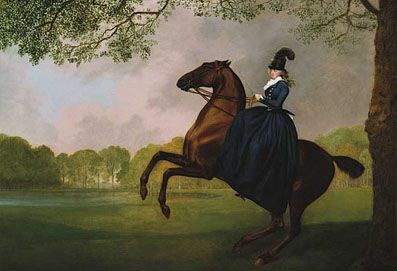 |
George Stubbs
The Royal Collection
I suppose persistence in pursuing an observations is useful.
I've been doing a large number of posts on East Asians in North America (Canada and the US), and how they have an aggressive, but alien, presence here.
A lot of my posts have been on how this group of people is picking what they think is the cream of the crop, including beta white males, who abandon their own culture and women in order to set house with them. I also have noted their more materialistic approach to life.
Below is an image posted at Laura Wood's The Thinking Housewife, with an Asian woman on horseback with a black man in a bare torso standing next to her and the horse. According to the correspondent, the image is from an ad from Photoshop, an image editing software, which shows actions used to enhance photos."
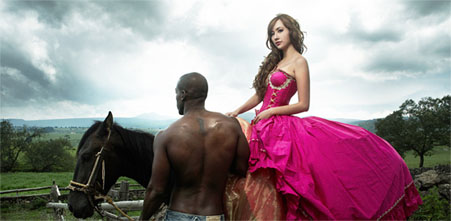 |
Now the irony is not lost on me that this correspondent couldn't see that the woman is Asian, and writes to Laura after reading Laura's post "Advertisers Love the Thrill of Black Man/White Woman." Photoshop must have done a pretty good job of "enhancing" the Asian woman to look more white than Chinese. Her hair is dyed a dark blond, and her eyes are heavily mascaraed to make them look bigger.
 |
The other irony is that Chinese women do want (or desire) enhancing in order to look more white. I see it all the time, with exaggerated eyeliners and hair dyed a lightish brown, so from a distance, or from the back, these Asian women look white. The purpose, I'm convinced, is to catch the white male, trying to look close enough to what he's used to, while adding that fetishistic "otherness" to get him attracted.
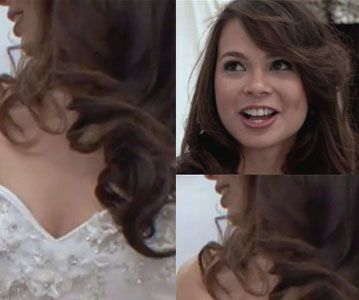 |
The photo collage above is from a TLC (The Learning Channel) show called "I Found the Gown" about brides looking for the "perfect" wedding dress. I find it fascinating because of the inordinate amount of time these young women spend on their wedding, not to mention the costs they incur. And also to see the kinds of marriages taking place in contemporary times. Most are racially compatible (blacks with blacks, whites with whites, etc.) but of the few that aren't, it is often a Chinese woman and a white male.
Often, although the Chinese bride will perform some part of the ceremony in the white and western tradition, she will bring in many elements of her background including even having a second ceremony. And she always has a large entourage of sisters, aunts and of course a rather dictatorial mother, who is really the one running the show.
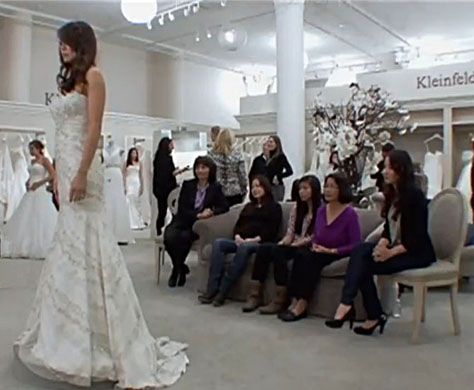 |
The Chinese bride from the collage above had with her a troupe of family members "helping" her decide on the dress. The tiny, dictatorial mother is in purple, and on the far left is an equally domineering grandmother. Sisters come along to give moral support, although they do not contradict the mother.
The strange thing about this episode was that the girl really didn't like the dress at the beginning, but through the relentless persistence of the two older women to pick it, and who bluntly told her they didn't like any of her other dresses, she caved in and seemed to have had a change of perception - she just liked what she didn't like. Perhaps this amnesia is the only way she can survive in her family.
Apart from having a white groom (as shown through various scenes in the episode), one thing that fascinated me about this Chinese woman was the subtle ways in which she changed her natural appearance. Her hair is clearly dyed a lighter brown, and her eyes are heavily mascaraed to appear larger and less oval shaped. Even her skin has a more reddish glow, but I think it is the effect of the light in the photograph.
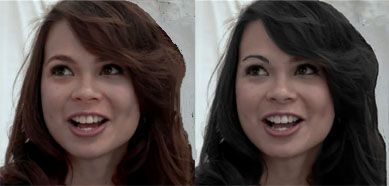 |
Before: With a reddish tint in her hair
After: Photoshopped to have darker hair and paler skin
But back to the original photo of the white-looking Asian female on horseback, with the black male standing by.
My first thought was Scarlett O'Hara in Gone with the Wind at her Tara plantation, with her billowing 19th century American Southern dress, and a black, protective slave by her side.
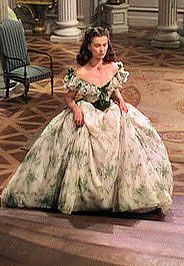 |
in her mansion at Tara, dress billowing
Scarlett, devastated by war and returning to her home Tara, vows:
As God is my witness, as God is my witness they're not going to lick me. I'm going to live through this and when it's all over, I'll never be hungry again. No, nor any of my folk. If I have to lie, steal, cheat or kill. As God is my witness, I'll never be hungry again.And she does recover Tara. But she is faced with another devastation when her only daughter with her persistent suitor-turned-husband Rhett Butler, dies. Bonnie Blue, like her mother Scarlett, was a bit of an equestrian, but her stubborn insistence that she could do it all on her horse cost her her life after an accident during a trial jump at the young age of four. Rhett Butler, her devastated father, couldn't face Scarlett after this death, and left her to nurse his grief.
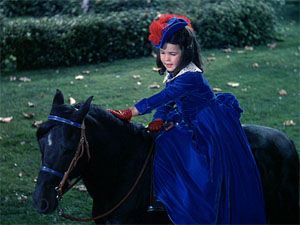 |
Unlike the aggressive but unimaginative white women of our era, who buckle under at the slightest (real) challenge, Scarlett stood up to her mistakes, and losses, and her last words in the film were:
Scarlett: Tara! Home. I'll go home. And I'll think of some way to get him back. After all... tomorrow is another day.If white women were able to demonstrate half of Scarlett's courage, they might be able to salvage some of what they've lost.
 |
The image above is from my blog post The Wrath of the White Woman, where I write:
And no-one will be on the side of the white woman: Not the white boyfriend who betrays her; the Asian female who has had her eye on him from early childhood; the Asian immigrant parents who are more than happy to have a white son-on-law and future half-Asian grand kids, who will be more Asian than white; and not the multi-culti climate that dominates Western countries these days.And, meanwhile, the fickle East Asian woman will go for the black man with his romantic image of the muscled protector. In her eyes, he will out-bid the modern white man as the more desirable, the more manly, male to catch.